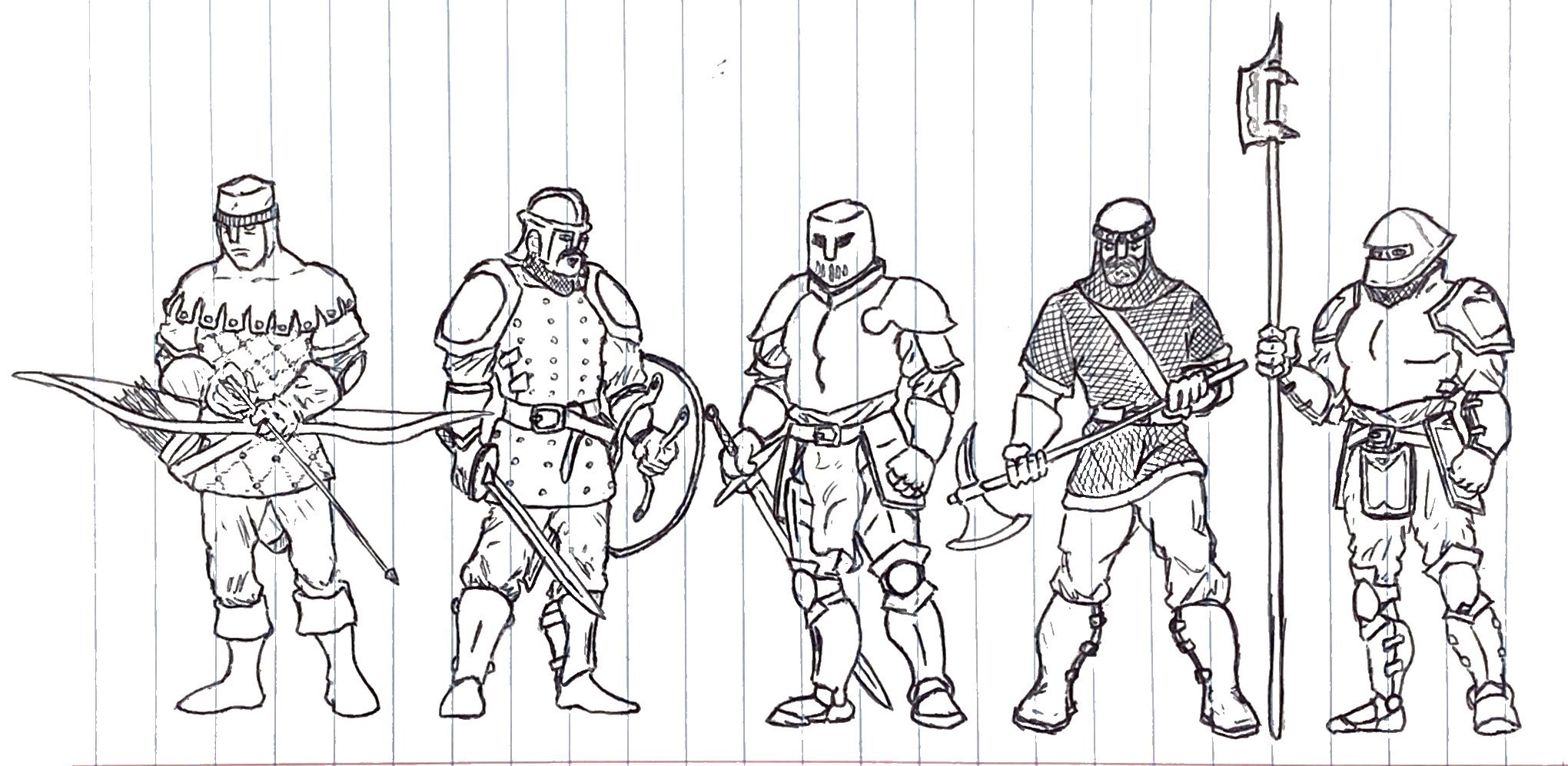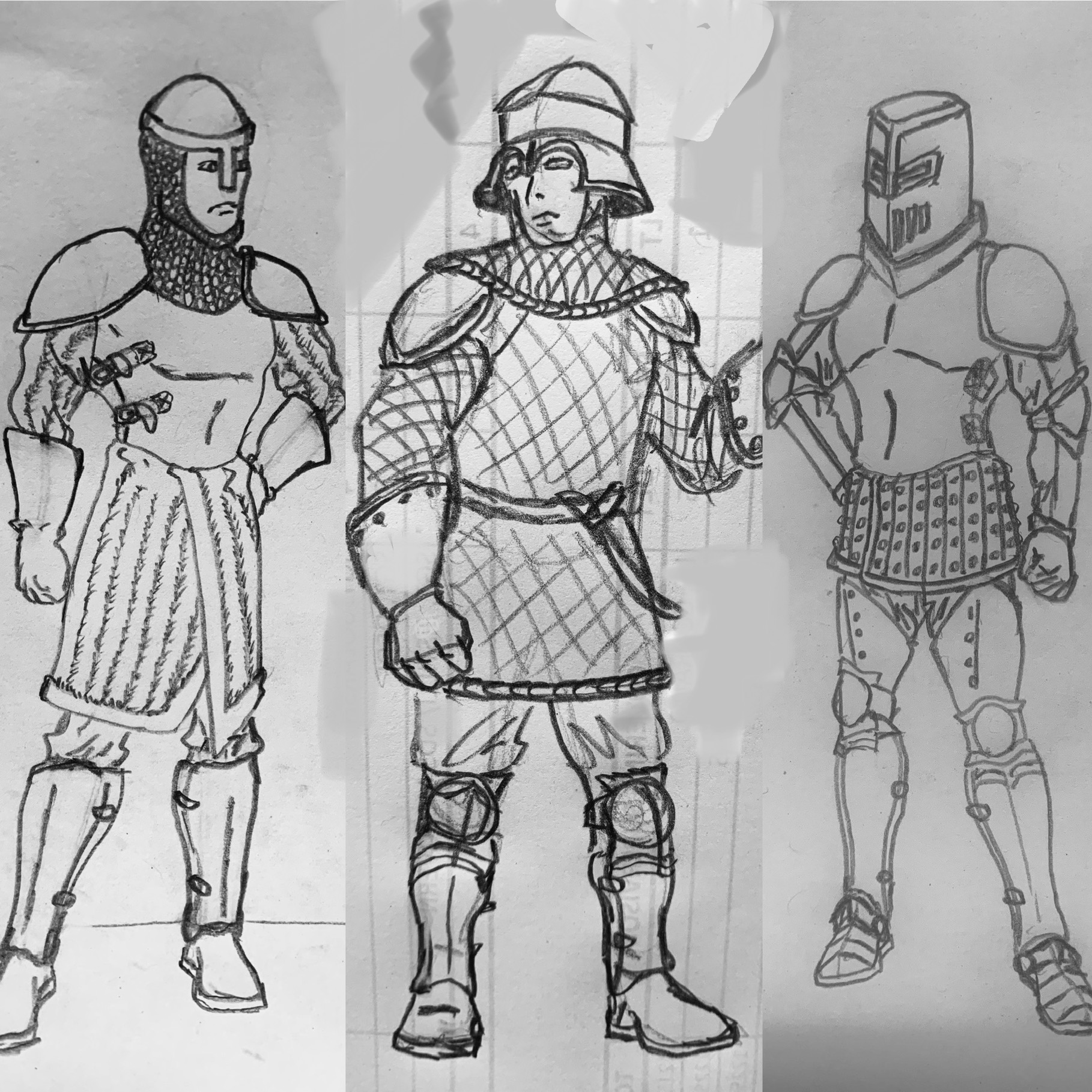Army
With many countries having compulsory practice on Saturdays, Sundays, and Holidays ensuring that there is always a moderately trained force of men ready for the levy. They can be raised for defense of their homes and estates with little notice. Require a Senights notice for the Fief or Shire, a Fortnight for the Province, and a Moon if they plan to march on another province. They cannot be forced to march more than a Senight away from their provincial borders.
Any Yeoman or Villein of fighting age, between the ages of 14 and 50 years, worth 40 must have a gambeson, helm, and weapon. Any of those that can ride are qualified for cavalry. Every fighting age Yeoman worth at least 200 must have a hauberk, helm, and weapon. Sign on for a fighting season at a time, generally from mid Spring to Mid-Autumn. They are expected to train and drill every morning, March 15 miles a day, and uphold the code of chivalry. Can be removed from service for violations of the code of chivalry or for serious transgressions against the gentry or clergy.
From squad leader up to the Cavalier, leadership roles ensure the combat readiness of those under their command and lead on the battlefield. Care for and maintenance of the pack mules and any carts the formations use falls under the leadership of said formations. Squad members drill daily and are checked for contraband. Successful service can lead to upward mobility in the social hierarchy.
Composition
Manpower
- Order: 2 or more Battalions make an Army, with a total of 8,400 or more fighting men.
- Battalion: 2 Banners make this formation, with a total of 4,200 fighting men.
- Banner: 3 Companies make this formation, with a total of 2,100 fighting men.
- Company: 8 Platoons make this formation, with a total of 700 fighting men.
- Platoon: This force is made up of 4 to 10 squads, with a total of 80 to 120 fighting men.
- Squad: The most basic military formation used by every major organization, consisting of between 8 and 30 fighting men.
Equipment
Light armor consists of a helm (flat top, conical, or spangen), coif, heavy gambeson with leather cuirass or hooded hauberk, hose and chausses, leather gloves and boots. Common shields are large wooden boss gripped tower, kite, or oval.
Medium armor consists of a helm (kettle or barbute), brigandine or cuirass with tassets over light gambeson, leather gloves with gauntlets, hose and chausses, leather boots with greaves. Common shields are medium steel plated wood, strapped round or heater.
Heavy armor consists of a helm (great helm or bascinet), with gorget, pauldrons, rerebrace and vambrace added to the cuirass, steel mittens, hose and chausses, and leather boots with greaves, poleyns, and sabatons affixed. Common shields are small steel plated wood, boss gripped round or strapped heater.
Weaponry
All fighting men carry a primary and secondary weapon, some carry a tertiary as well. Infantry carry a polearm (billhook, bardiche, vouge, ox tounge, fauchard, or spear) while cavalry carry a lance or spear, and archers carry a long or short war bow. As a secondary weapon most carry either an arming sword or long dagger (stiletto, rondel or bollock). Tertiary weapons can include a smaller dagger, knife, hand axe, or bludgeoning weapon.
Weapons of prestige include a war hammer, crows beak, halberd, morning star, and glaive.
Vehicles
- Mules: offspring of a donkey and horse, used as a beast of burden.
- Pony: small breed horse.
- Palfreys: docile horse used for ordinary riding, especially by women.
- Rouncey: all purpose horse used for burden, riding, and war.
- Courser: a swift horse, commonly used for messengers.
- Chargers: a cavalry horse, trained for battle.
- Destrier: a knights war horse.
- Colts: uncastrated male horse.
- Mares: female horse.
- Gelding: castrated male horse.
Structure
Each component formation has its own leader, with its own retinue. The Army itself has its own leader apart from that, with its own retinue.
| Knight | Cavalry | Infantry | Ranged | |
| Order | Cavalier | |||
| Battalion | Commander | |||
| Banner | Banneret | |||
| Company | Companion | Master Sergeant | ||
| Platoon | Bachelor | Esquire | Sergeant-at-arms | Centenar |
| Squad | Squire | Hobilar | Man-at-arms | Vintenar |
Tactics
Common offensive tactics include slow advance in line, with weapons pointed, and charging in a wedge. Taking full advantage of the mixed makeup of their formations, they have infantry form up the center with ranged in the rear, cavalry making up the flanks.
Common defensive tactics include shield or spear wall and encircling with shield and/ or spears pointed.
Training
Many countries require fighting aged males to practice with their chosen weapon twice a week. Upon being called for the levy or conscripted they undergo a senight of marching drills before heading out on campaign. During the campaign they are drilled every morning to maintain battle readiness. After that, any man who wishes to make fighting their profession is responsible for their own level of training.
Weapon systems:
- Bludgeon- mace or maul. Knobbed, flanged, or spiked.
- Axe- one or two handed, throwing, bearded, or pick.
- Sword- straight or curved blade, single or double edged, and one or two handed.
- Dagger- slashing, stabbing, or throwing.
- Polearm- spear, lance, or javelin. With axe, leaf, sickle, club, or trident head.
- Bow- long or short war bows. Crossbows are for gentry only.
- Shield- tower, kite, oval, heater, or round. Large, medium, or small, and flat or domed.
- Shield and sword or dagger.
- Shield and axe or club.
- Shield and spear.
- Sword and dagger.
- Sword and axe or club.
- Sword or dagger and cloak.
Logistics
Logistical Support
Each squad has at least one mule carrying their gear, including a tent and disassembled siege equipment, tended by two servants. Some have one or more two wheeled carts pulled by two mules carrying their gear, tended by three servants. The mules are cheap to feed and can forage off the land easily. Each squad is responsible for their own baggage, but the baggage trains are organized per company.
Taylors, girdlers, linksters, armorers, heumers, cobblers, blacksmiths, cutlers, billiers, grinders, cooks, thatcher's, masons, weavers, carters, porters, grooms, and messengers all travel with the formation among the baggage trains.
Upkeep
| Daily | Wages | ||||||
|---|---|---|---|---|---|---|---|
| Cavalier | 120 | ||||||
| Commander | 96 | ||||||
| Banneret | 72 | ||||||
| Companion | 48 | Master Sergeant | 28 | ||||
| Bachelor | 24 | Esquire | 22 | Sergeant-at-arms | 18 | Centenar | 20 |
| Squire | 20 | Hobilar | 18 | Man-at-arms | 10 | Vintenar | 10 |
| Armati | 15 | Lancer | 5 | Paviser | 7 | ||
| Rider | 12 | Milite | 3 | Archer | 5 |
Recruitment
Local nobles can call a levy or conscript men at the direction of higher nobles. They can require every family to provide one fighting age male, their social standing would dictate what equipment they must bring as well. Previous service determines at what rank they are hired. Those who seek to fight as a profession, mercenaries, must seek out the officers and apply for work. Sometimes entire companies can be mercenary.
Type
Infantry
Vehicles Used
Overall training Level
Semi-professional
Assumed Veterancy
Trained




Comments